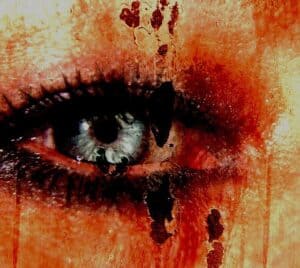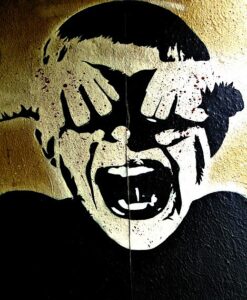
Allegations of abuse at the former Dozier School for Boys have rocked the town of Marianna, FL, leading to an outcry among the citizens.
“What a piece of human trash.”
“Should have put him in front of a wall and shot him.”
“This dude is a fucking monster — the kind of person that nightmares are made of.”
“He’s a cruel, twisted, sadistic scumbag.”
“I wanna reach through the screen and strangle him.”
“Lying sack of shit should be held down and beat to death.”
These are comments on YouTube directed at an 84-year-old man by the name of Troy Tidwell, a resident of the town of Marianna located in the Florida panhandle about 30 miles northwest of Tallahassee. Tidwell is accused of participating in the vicious beatings of young boys placed in his charge at the Florida Industrial School for Boys in the 1950’s and 60’s.

Is this man a monster? Video of a deposition of Troy Tidwell posted on YouTube that drew such harsh comments.
According to more than a hundred victims who have come forward, the beatings at the juvenile detention facility were routine, arbitrary and sadistic. Allegedly, the beatings resulted in the deaths of several boys who were buried in unmarked graves at the site. Tidwell was one of several perpetrators, according to accusers, who were part of a longstanding culture of abuse that flourished at the institution over many years.
The YouTube video shows Troy Tidwell in a deposition where he denies abusing the boys. He calls it “punishment”. Many people are outraged.
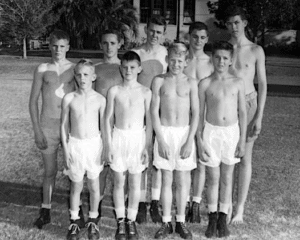
Group portrait of boys at the Florida Industrial School for Boys in the 1950’s. Hundreds of former inmates have come forward with allegations of abuse.
Yet some people who live in and around Marianna tell a different story. They remember Troy Tidwell as a pillar of the community, a calm, decent, churchgoing man who was good to his family, never beat his children, and loved dancing the foxtrot. To them the allegations are specious and they fear for the reputation of the man and their community:
“Oh Sweet Jesus! First of all, I am sick and friggin’ tired of hearing about all of this stuff that happened in the past, but has the potential to cause harm to the present economy of OUR city. The city that we all live in NOW.”
“This is a witch-hunt and always has been.”
“Oh u know they’ll come out of the woodwork. None of them will miss a chance to be ‘oppressed’ or better yet, reap a check out if this! Just wait, it’s coming. Somebody will ‘owe’ them something.”

Idyllic postcard image of the Florida Industrial School for Boys. In truth, according to some, it was a house of horrors.
What is Owed
After receiving our meal, we sat down at one of the tables around the large room. At each seat was a six-inch-tall bottle of milk. On top of each bottle of milk rested about three-quarters of an inch of cream… One boy would continuously shake the bottle secretly beneath the table until the cream and milk had been formed into a lump of butter. Then we’d all spread the butter on our toast or bread.
During this particular meal and butter-churning process, several adults stepped into the dining hall doorway…

The dining hall at the Florida Industrial School for Boys where Roger Dean Kiser alleges the bottle shaking incident occurred.
I looked over and noticed that the boy shaking the milk bottle had not noticed the adults walking toward our table. As they neared us, one of the women let out a terrified scream. “Oh, my God!” she cried. “He’s masturbating.”
Mr. Hatton grabbed the boy and jerked him up from his seat. The glass bottle went flying. Mr. Hatton began beating the boy with his fists about his face and head. Minutes later the boy was being dragged out of the building. Mr. Hatton, Mr. Tidwell, and three other men were headed for the White House with the boy in tow. The men slapped and kicked him as they dragged him through the dirt and leaves like he was a worthless bag of trash.
The entire dining hall remained completely silent for an extraordinarily long time. Horror remained in many eyes and on many faces for the entire meal.
The boy was never seen again.
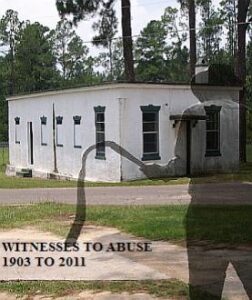
According to Kiser and others, the strap had a stainless steel band woven into it and the blows were administered with full, round-house vigor.
The foregoing recollection is from Roger Dean Kiser, a former inmate at the Florida Industrial School for Boys, as recounted in his book The White House Boys: An American Tragedy. Kiser spent several years at the school in the early 1960’s.
Abandoned by his mother at age five, rescued from abusive foster parents a year later and sent to an orphanage where he was sexually molested by his head mistress, Kiser led the kind of nightmarish childhood that would make Charles Dicken’s blanch. His arrival at the Florida Industrial School for Boys seemed to promise relief from his ordeal, but he would soon discover otherwise.
He wasn’t there long before he was sent to a small, whitewashed stucco building on the grounds of the school, a place known as “the White House”. At the White House Kiser was ordered to lie face down on a bed and grab the headboard. He was then mercilessly beaten with a leather strap.
According to Kiser and others who endured it, the strap had a stainless steel band woven into it and the blows were administered with full, round-house vigor. When it was over Kiser was covered in blood, his clothing was in tatters and the cotton material of his underwear was embedded so deeply into his wounds it had to be removed with a pair of tweezers.
And what had he done to deserve such a punishment?
Someone had reported that he had said the word “shit” when he’d slipped on the diving board at the pool.
Hard-hearted

Marianna, Florida today. Plenty of people here are upset at the allegations that have cast their community in such a grim light.
Still, there are those in Marianna today outraged that anyone would dare to bring up such things. They want them left in the past and forgotten lest they sully the good name of the community. The only problem is that the people to whom they happened are still alive – or at least some of them are – and they are owed a measure of justice. Or are they?
As one commentator writing in response to an article in the Florida Times-Union about Roger Dean Kiser said:
“Nice try, Rog. But it didn’t work. Next time you might try suing McDonalds for a cup of coffee that was too hot. Or, you might actually try working for a living.”
One can be forgiven for concluding that at least some of the citizens of Marianna are pretty hard-hearted. Unfortunately, a little digging into Marianna’s past only serves to reinforce that impression because, as it turns out, this isn’t the first time Marianna has shown an ugly face to the world, not by a long shot.

Lynchings like this one were all too common in the South in the early part of the 20th century but the lynching of Claude Neal in Marianna was on another level.
The Ugly Face of Marianna
In the autumn of 1934 a young woman named Lola Cannidy was found slain outside the town of Greenwood, a few miles north of Marianna. She had been raped and bludgeoned to death with a hammer. An African-American farmhand named Claude Neal was arrested and taken into custody. The weight of evidence was against him, but before a jury could bring charges against him, a mob formed.
Police, fearing the mob, moved Neal several times, but the mob tracked him down, catching up with him in Brewton, Alabama and, using trickery, snatched him out of police custody and spirited him away to Peri’s Landing on the Chattahoochee River just east of Marianna where they announced their intention to lynch him. Before long, the story got out in the national media and soon the whole country was alerted to what was about to happen.
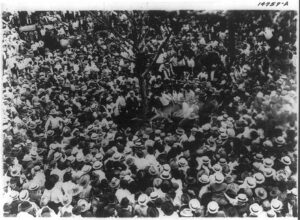
Large lynch mobs like this one often turned out to exult in killings. The lynch mob that turned out to see Claude Neal reportedly numbered 2,000.
At Peri’s Landing Claude Neal was beaten, stabbed, burned with hot irons and castrated before being hung by the neck until dead. Then the corpse was tied to the back of a car and dragged to the father of the slain girl. Annoyed that he had not been permitted to deliver the killing blow, Lola Cannidy’s father shot the corpse three times before turning it over to the mob, which further mutilated the body by kicking it, stabbing it and running over it with a car.
After that, the body was conveyed to Marianna where it was hung upside down in a tree outside the courthouse as the mob exulted. The mob didn’t care what outsiders thought of what they had done, but the sheriff, perhaps apprehending the disapproval of the national media, had the body cut down and buried. This irked a good many of the citizens of Marianna.
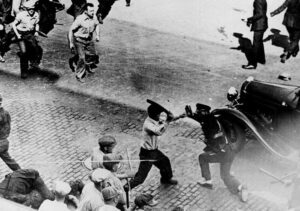
When the sheriff refused to exhume the body and hang it back up in the tree, the crowd rioted. Note: This image is of a different US riot that occurred the same year.
Two thousand of them gathered on the courthouse lawn demanding to see the mutilated corpse and demanding that the sheriff exhume the body and hang it back up in the tree. When he refused, they rioted. Numerous black homes were burned. At least 200 innocent people were injured. The police were attacked. Eventually, the National Guard was called in.
The rest of the country saw what was going on and was appalled. The subsequent outcry gave impetus to legislation that created the Civil Rights Division of the U.S. Department of Justice, a government agency that returned to Marianna 85 years later to bring new charges.
Brutal Legacy
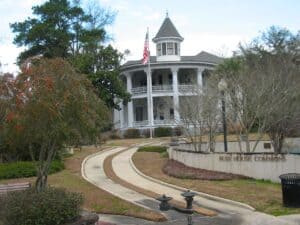
Marianna wants to be known as “the City of Southern Charm” and prefers to showcase its stately antebellum homes.
Marianna wants to be known as “The City of Southern Charm”. It wants to showcase its gorgeous antebellum homes. It wants to benefit from its proximity to Florida Caverns State Park. It envisions a quaint downtown filled with boutiques and gift shops. A walk through downtown Marianna, however, shows this has been uphill battle (as it has been for countless other small American cities with the same idea). Prominent storefronts are vacant, many of them with signs and awnings indicating that a coffee shop or boutique once there is now gone. Parking slots set aside for visitors are empty.

Today the Dozier School for Boys has been shut down and is enclosed by a forbidding electric fence topped with razor wire more to keep the curious out than the guilty in.
Accusations of child abuse and murder at the school are only making things more difficult for Marianna, and the negative media attention generated by those accusations threatens to disgorge that other horrible incident in Marianna’s past, the lynching of Claude Neal. Judging by the reaction of viewers to the Troy Tidwell deposition, social media will not be inclined to be sympathetic when they learn the full weight of Marianna’s brutal legacy. But why should today’s citizens have to answer for that? That was in the past. Dredging it up is like visiting the sins of the fathers on the sons? It’s not fair. And to infer anything about the current populace of Marianna based on the horrible behavior of those in the past is the worst kind of prejudice. It’s just wrong – sort of like assuming all boys sent to a juvenile detention facility deserved to be brutally flogged or that all blacks should be held responsible for the transgressions of one.
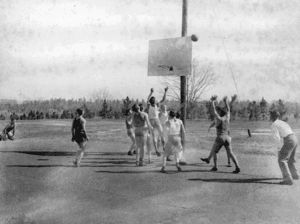
Ironically, in the 1950’s and 60’s, the campus was open. The basketball court shown here is in the same place obscured by the fence in the image above.
The town of Marianna is the victim of an injustice. So one would think there would be some compassion in the voices coming out of Marianna about the injustices suffered by others. If so it has been drowned out by the cries of indignation from those who feel they are being persecuted by the media and the state of Florida.
And why are the media and state of Florida suddenly so interested in Marianna?
Well, it has to do with that measure of justice due to Roger Dean Kiser and the White House Boys.
Digging Up the Past

In this 90 sec video Florida Senator Bill Nelson and the USF research team tour The White House where the abuse allegedly occurred as well as the nearby graveyard.
After years of reported abuse at the school, which in later years went by the name of the Dozier School for Boys, the U.S. Department of Justice Civil Rights Division opened an investigation in 2011. Six months before the findings were released the school abruptly closed. Jobs were lost. A significant source of revenue for the town of Marianna suddenly dried up. And then the results of the investigation came out.
The investigation found “credible reports of misconduct by staff members to youth within their custody” and “systemic, egregious, and dangerous practices exacerbated by a lack of accountability and controls.” It found “youth confined at Dozier and at JJOC were subjected to conditions that placed them at serious risk of avoidable harm in violation of their rights.”

In this 2 min video Senator Bill Nelson calls for accountability in front of the White House ahead of the exhumations of the unmarked graves.
In other words, this has been happening right up until recently, giving credence to the accusations of the The White House Boys that a culture of abuse had existed at the school for decades, a culture that reached its high point in the 1960’s when, as they allege, a number of boys were beaten to death.
On the heels of the investigation a research team from the University of South Florida, working in cooperation with the Florida state’s attorney general, began exhuming the unmarked graves on the site in the summer of 2013. Their task, ostensibly, is to find out who is buried there, but also by extension to find out what happened to them. By January of 2014 they had unearthed 55 bodies, 24 more than official records recorded.
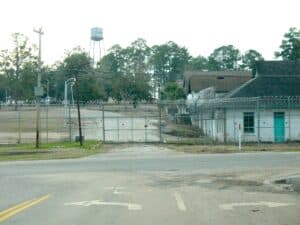
Which way to turn? Side entrance of the shuttered Dozier School for Boys. Some townspeople wonder why they should have to pay a price for what went on here.
This should be a sobering finding to those decrying the unfair treatment of the town. Given the invective directed at Troy Tidwell in social media, now would be a good time to fall mute, to get on the right side of things should the findings get worse. But there are those in Marianna who just won’t give it up, whose sense of persecution blinds them to the suffering of others and who insist they are the only victims.
The Danger of Forgetting
On the town square in Marianna stands a handsome modern courthouse. It is the county seat for Jackson County. It replaced the previous courthouse on the site, the one that stood there in 1934 when Claude Neal was hung from a tree. In fact, a large, old tree stands there today. It has a thick perpendicular branch about ten feet off the ground, ideal for hanging someone. It may or may not be the actual tree. Some say it is, some say it isn’t.
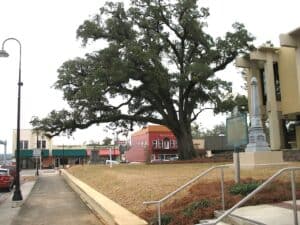
The courthouse lawn. A large, old tree with a perpendicular branch ideal for hanging someone. Is this the tree where Claude Neal was hung in 1934. Does it matter?
There are a couple of historic plaques on the courthouse lawn but none to commemorate the infamous incident that took place there in 1934, and for good reason. If a vote were taken today the citizens of Marianna, black and white, would probably agree that this is an event best left in the past. But getting in the habit of forgetting the past can have unintended consequences. It can allow you to accept that denial is a substitute for truth, that brushing things under the rug can make them go away, which can leave you vulnerable when the truth finally does emerge.
The Abused

Two inmates holding eggs. Black and white boys were housed in separate facilities. Some former inmates allege there are two separate graveyards, meaning there may be even more unmarked, as yet undiscovered graves.
Forensic work is beginning on the bodies found in the unmarked graves on the school site. If it is discovered that the bodies are those of young boys beaten to death, the media firestorm that descends on Marianna will be unlike anything they’ve witnessed since 1934.
If that happens, the town’s knee-jerk defensiveness and lack of compassion may do more to sully its reputation than the acts of the brutal sadists who ran the school.
It’s ironic that those who bristle at the indignation and entitlement of the abused fail to recognize those same defects in themselves. In their eyes they are the ones being abused and they want the media and investigators to leave them alone. But if that were to happen, gross injustices would be allowed to stand, heaping further injuries on the victims.
The investigation is necessary, if for no other reason, than to ferret out whom is truly aggrieved in Marianna, the townspeople whose economy is endangered by allegations of abuse, or a bunch of old men who were once boys whose lives were shattered by the sadism of their “caretakers” in “the City of Southern Charm.”
Previous stop on the odyssey: Fort Myers, FL //
Next stop on the odyssey: Austin, TX
Sources:
Donague, Erin, 55 Bodies Exhumed at Shuttered Reform School, CBS News Online, 28 Jan 2014, 1 Feb 2014
Fountain, Edmund, D., For Their Own Good, YouTube Video
Kiser, Roger Dean, The White House Boys, Health Communications Inc., Deerfield Beach, FL 2009
McGovern, James R., Anatomy of a Lynching: The Killing of Claude Neal, LSU Press, Baton Rouge, LA 1992
Montgomery, Ben, In Marianna, Dig for Truth Encounters Desire to Keep Past Buried, Tampa Bay Times, 13 April 2013, 5 February 2014
Schoettler, Jim, White House Boys Reach End of Weary Road, Florida Times Union, 12 March 2010, 2 Feb 2014
Tampabay.com, Troy Tidwell Deposition, YouTube Video
Topix forum: The community defends Tidwell “Sick Ass Dozier Peeps” http://www.topix.com/forum/city/marianna-fl/TG888U93PNDCHG6FR
Towey, Megan, The Search for the Dead: Former Inmates at Shuttered Dozier Juvenile Detention Facility Detail Alleged Abuse, CBS News Online, 9 Aug 2013, 1 Feb 2014
Image credits:
Crying boy, URBANARTefakte; Troy Tidwell YouTube Video, RDK & Tampa Bay Tribune; Group portrait of boys at Florida State Industrial School for Boys, State Archives of Florida, Florida Memory; Postcard of institution, Public domain; Boys in the Dining Hall, State Archives of Florida, Florida Memory; White House with abuser in silhouette, White House Survivors Organization; Eye of the abused, Heidi; Downtown Marianna, Malcolm Logan; Men at a lynching, Public domain; Lynch mob, Public domain; 1934 Riot, Public domain; Antebellum home, Malcolm Logan; Electric fence, Malcolm Logan; Boys Playing Basketball, State Archives of Florida, Florida Memory; Tour of White House video, University of South Florida; Bill Nelson video, University of South Florida; Dozier School side entrance, Malcolm Logan; Courthouse lawn, Malcolm Logan; Two inmates holding eggs, State Archives of Florida, Florida Memory


